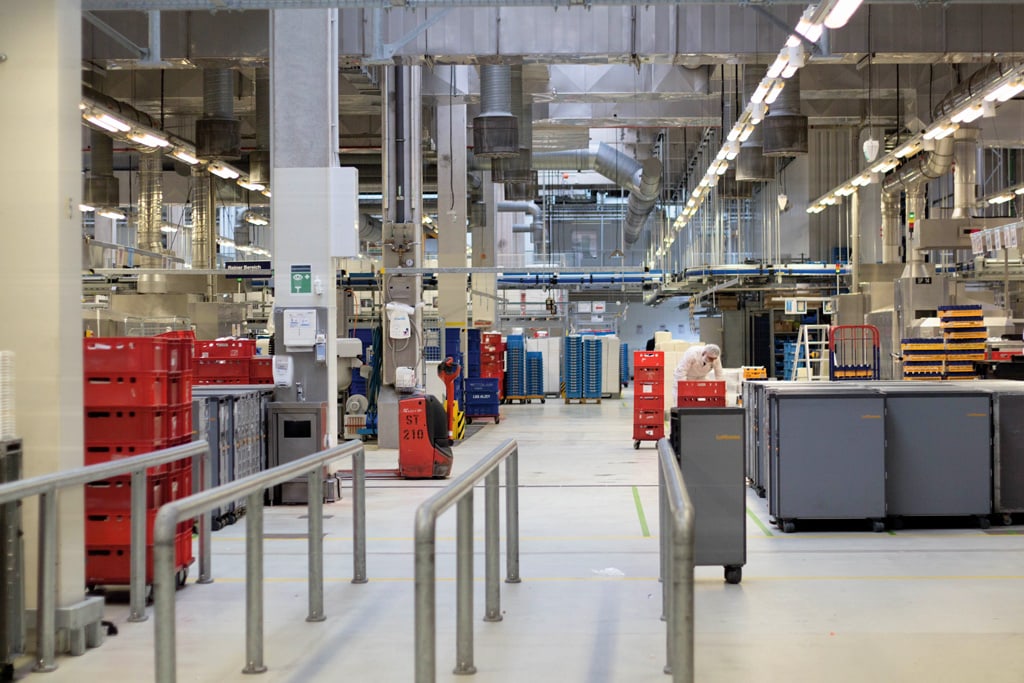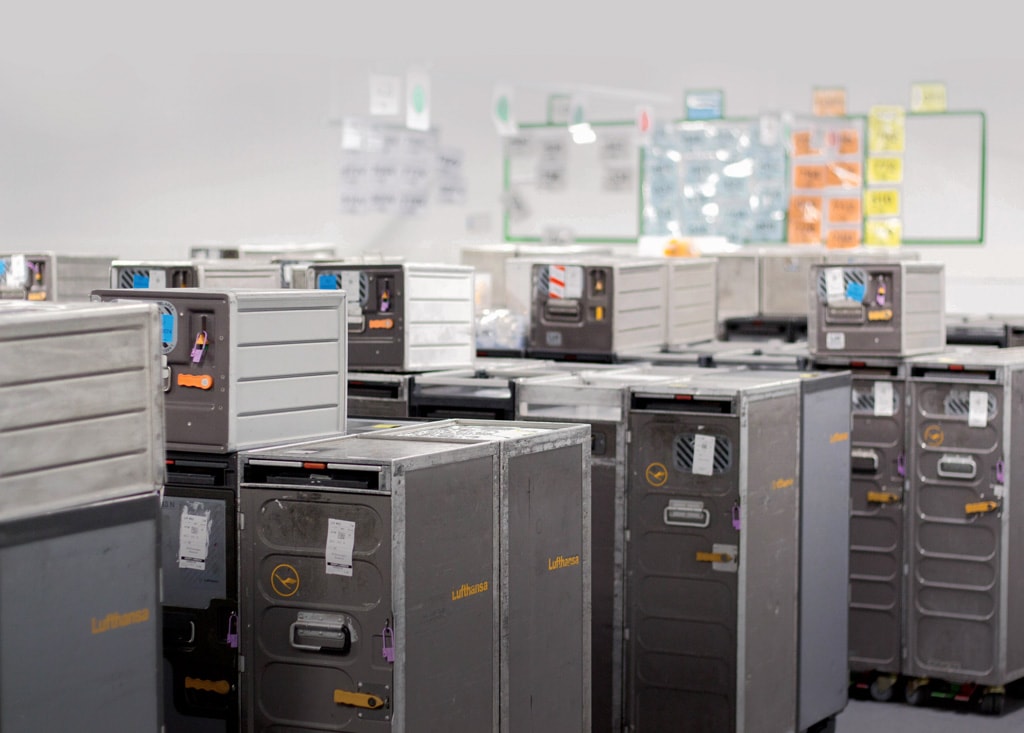LSG Sky Chefs: The Logistics of Everything Loose
Share

APEX Insight: Food is not the main priority for LSG Sky Chefs – it’s the punctual loading and unloading of trolleys containing thousands of pieces of equipment on 450 flights a day that keeps them busiest.
Flight catering is one of the most complex global supply chains in the world, linking a network of airlines, distributors, caterers and suppliers. Not many businesses involve receiving used or dirty things, cleaning them and sending them off to be used again. But this is the labor of LSG Sky Chefs, sorting, washing and loading trolleys that contain everything loose from inside an aircraft: from meal trays to duty-free goods, and even customs declaration forms. On an A380, that’s 37,000 pieces of equipment weighing up to 6.5 tonnes.
“Everything depends on the step before.” – Olaf Mauthe, LSG Sky Chefs
As soon as a trolley enters the catering facility, it is emptied. Organic waste is sucked into an underground cellar to be burned, while trolleys are whisked off on a monorail to be washed. Cutlery, dishes and trays are sorted by their cabin class, because not all dishes are treated equally.
“Glasses require a different kind of water, heating, and a different kind of chemical,” says Olaf Mauthe, managing director of the LSG Sky Chefs Frankfurt facility. “At the end of the cleaning, you need special water to prevent dots that stay on.” Artificial sunlight emanating from beneath the conveyor belt helps to verify the glasses are crystal clear. “The quality you have to produce for airline catering is much higher … At home, it’s not very important, but here, it’s a big quality issue … Our task is to prevent that, because a passenger on a flight has enough time to check all the different things.”
Every step has its set of procedures to fulfil its purpose in the cycle. In the kitchen, even raspberry compote is reduced to a list of ingredients, their weight in grams and a photo for what the dish should look like. In a system that has been set up to run like an infinite domino effect, “Everything depends on the step before,” Mauthe emphasizes. “Our task is to create a circle, a never-ending circle.”

Order of the Day
Even on a scheduled flight, there is always a short order – a last-minute request that sends a passenger car speeding down the tarmac to deliver a couple of meals because airlines always load less food than ordered. “If an airline books 300 passengers, it could be that the airline ordered only 250 meals … and at the end of the day, it’s a short order to fill up the right amount,” Mauthe says.
Mauthe receives the first figures for an airplane load one week before departure. At this point, he has a rough idea of how many blankets, pillows, headsets and in-flight magazines to load, but he receives updates every few hours, and it’s not until six hours before a flight that he has a clear picture of the exact numbers to deliver – kind of. Mauthe explains the last call agreement with airlines: “Even 40 minutes before departure you can still have changes… and you have to deliver because the passengers cannot be without food.”
Loading extra meals increases weight and costs for airlines looking to minimize buffer. “They kind of really transfer the risk to us,” says Josefine Corsten, senior vice-president of Corporate Communications at LSG Group. And with a product as fickle as food, it’s not easy. “To work with food with a high volatility, it’s extremely sensitive,” Mauthe adds. Cooked foods need to be chilled at 41°F or frozen all the way to the aircraft, and depending on what gate it’s at, at Frankfurt Airport, for example, it could be a 45-minute drive from the catering facility. “You have to make sure that the food is safe,” he explains. “That’s the number one priority. But it’s only one priority.”

Complexity of Choice
In a 24/7 production cycle that involves managing the preparation of 85,500 meals, 2,000 employees, 150 high loaders and delivering equipment to 450 flights a day, it seems that automation would be key to efficiency. But when you’re producing a multitude of small items with high levels of complexity, automation isn’t necessarily more efficient. “We are looking at automation … [But it’s] not easy because we have so much hand work … We have so many different things to produce because of the demand of the airline, because of the passenger,” Mauthe says. As a result, the variety of service concepts makes it difficult for LSG Sky Chefs to automate en masse.
“Today there are so many business models in catering.” – Josefine Corsten, LSG Group
Variety may be the spice of the passenger experience, but it creates a challenge for flight catering, which the president of KLM catering once described as 70 percent logistics and 30 percent cooking. “Today there are so many business models in catering,” Corsten says. The options are as varied as the color combinations on a Rubik’s Cube. “It can’t be planned for. And we see airlines changing their concepts overnight.”

Part of this demand is driven by trends on the ground: on-demand delivery, digitalization, personalization; the turnaround cycle is becoming shorter and shorter. “You can compare passenger or consumer expectations when it comes to airline catering with shopping behavior on the web,” Mauthe says. “Today, you can order anything from Amazon. This trend will for sure also influence passenger demand in the airline and airline catering business.”
To cater to the 108 million passengers that the Lufthansa Group airlines fly in a year, meals are tailored to passengers on routes to and from China, Japan, India, Southeast Asia and the United States. Airlines are continually rotating their menus, making them seasonal, collaborating with different chefs to market in-flight dining.
The growing movement toward personalization has also led LSG to develop a concept that would allow passengers to create their own vacation keepsake by sending a photo that could be printed on an amenity kit bag and having it delivered to their seat. Personalization may add another layer of complexity, but pre-ordering and technology-enabled buy-on-board options are also helping to simplify things.
So Much More Than Sandwiches
At the end of the day, Mauthe says complexity is what keeps things interesting. “Some people think we only deliver beverages and sandwiches on a plane,” he says. “The mix of logistics, time pressure, people management, different cultures and everyday [management of] different things. That’s the most interesting part of all, I think.”
This story was originally published in the June/July issue of APEX Experience magazine.
To learn more about flight catering, read “Everything You’ve Ever Wondered About Airline Food.”


